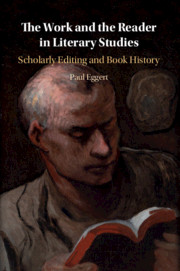Book contents
- The Work and the Reader in Literary Studies
- The Work and the Reader in Literary Studies
- Copyright page
- Dedication
- Contents
- Figures
- Preface
- Chapter 1 Introduction
- Chapter 2 Reviving the Work-Concept
- Chapter 3 The Digital Native Encounters the Printed Scholarly Edition Called Hamlet
- Chapter 4 The Reader-Oriented Scholarly Edition
- Chapter 5 Digital Editions
- Chapter 6 The Work, the Version and the Charles Harpur Critical Archive
- Chapter 7 Book History and Literary Study
- Chapter 8 Book History and Literary Study
- Chapter 9 Adaptation, Folklore and the Work
- Chapter 10 Conclusion
- Notes
- Bibliography
- Index
Chapter 3 - The Digital Native Encounters the Printed Scholarly Edition Called Hamlet
Published online by Cambridge University Press: 19 August 2019
- The Work and the Reader in Literary Studies
- The Work and the Reader in Literary Studies
- Copyright page
- Dedication
- Contents
- Figures
- Preface
- Chapter 1 Introduction
- Chapter 2 Reviving the Work-Concept
- Chapter 3 The Digital Native Encounters the Printed Scholarly Edition Called Hamlet
- Chapter 4 The Reader-Oriented Scholarly Edition
- Chapter 5 Digital Editions
- Chapter 6 The Work, the Version and the Charles Harpur Critical Archive
- Chapter 7 Book History and Literary Study
- Chapter 8 Book History and Literary Study
- Chapter 9 Adaptation, Folklore and the Work
- Chapter 10 Conclusion
- Notes
- Bibliography
- Index
Summary
Learning how to use a printed scholarly edition of a literary work does not come naturally to digital natives. Chapter 3 dramatises the learning curve of coming to grips with scholarly editions of Hamlet, of appreciating the argument that each one mounts about the surviving textual and other materials, and of learning how to appreciate the internal architecture and cross-referencing of editions without hyperlinks.
Different modes of scholarly editing are described, especially the competing methodologies and limits of the necessarily non-definitive Anglo-American critical edition. It professes to present a reading text of the work; the German historical-critical edition represents the work in a more archival fashion.
A case-study of recent attempts to solve the editorial problem of Hamlet is offered via an analysis of the Arden 3, Norton 3 and New Oxford’s editorial rationales. Their common abandonment of belief in bibliographic analysis is questioned. Confusion about the nature of the work-concept as applied to Shakespearean drama is revealed as held in common.
Keywords
- Type
- Chapter
- Information
- The Work and the Reader in Literary StudiesScholarly Editing and Book History, pp. 35 - 63Publisher: Cambridge University PressPrint publication year: 2019

